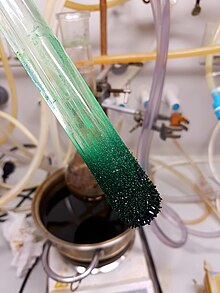
Back نيكلوسين Arabic نیکلوسین AZB Niklocen Czech Nickelocen German Niqueloceno Spanish نیکلوسین Persian Nikkeloseeni Finnish Nickelocène French Nichelocene Italian ニッケロセン Japanese
| |||

| |||
| Names | |||
|---|---|---|---|
| Preferred IUPAC name
Nickelocene[1] | |||
| Other names
Bis(cyclopentadienyl) nickel(II)
| |||
| Identifiers | |||
3D model (JSmol)
|
|||
| ChEBI | |||
| ChemSpider | |||
| ECHA InfoCard | 100.013.672 | ||
| EC Number |
| ||
| 3412 | |||
PubChem CID
|
|||
| RTECS number |
| ||
| UNII | |||
| UN number | 1325 3082 | ||
CompTox Dashboard (EPA)
|
|||
| |||
| |||
| Properties | |||
| C10H10Ni | |||
| Molar mass | 188.88 g/mol | ||
| Appearance | Green crystals | ||
| Density | 1.47 g/cm3 | ||
| Melting point | 171 to 173 °C (340 to 343 °F; 444 to 446 K) | ||
| insoluble | |||
| Structure | |||
| D5h, D5d | |||
| 0 D | |||
| Hazards | |||
| GHS labelling: | |||
  
| |||
| Danger | |||
| H228, H302, H317, H350 | |||
| P201, P202, P210, P240, P241, P261, P264, P270, P272, P280, P281, P301+P312, P302+P352, P308+P313, P321, P330, P333+P313, P363, P370+P378, P405, P501 | |||
| NFPA 704 (fire diamond) | |||
| Lethal dose or concentration (LD, LC): | |||
LD50 (median dose)
|
490 mg kg−1 (oral, rat) 600 mg kg−1 (oral, mouse) | ||
| Related compounds | |||
Related compounds
|
CoCp2, FeCp2 | ||
Except where otherwise noted, data are given for materials in their standard state (at 25 °C [77 °F], 100 kPa).
| |||
Nickelocene is the organonickel compound with the formula Ni(η5-C5H5)2. Also known as bis(cyclopentadienyl)nickel or NiCp2, this bright green paramagnetic solid is of enduring academic interest,[2] although it does not yet have any known practical applications.
- ^ International Union of Pure and Applied Chemistry (2014). Nomenclature of Organic Chemistry: IUPAC Recommendations and Preferred Names 2013. The Royal Society of Chemistry. p. 1041. doi:10.1039/9781849733069. ISBN 978-0-85404-182-4.
- ^ Elschenbroich, C. (2006). Organometallics. Weinheim: Wiley-VCH. ISBN 978-3-527-29390-2.


